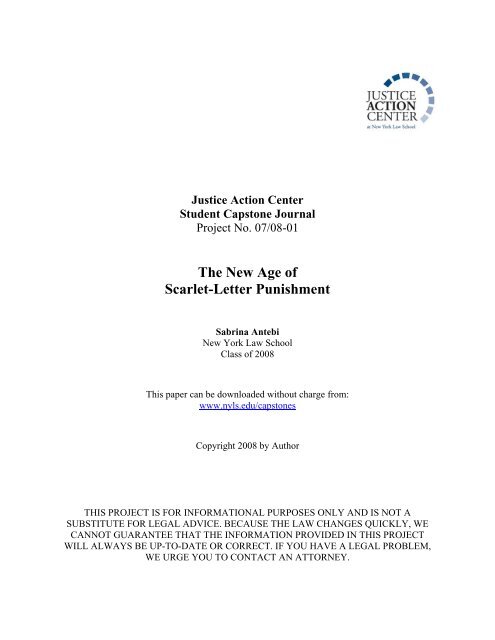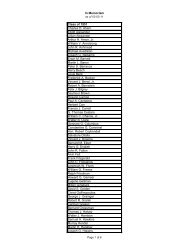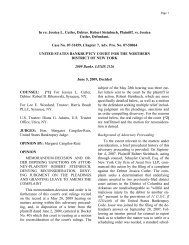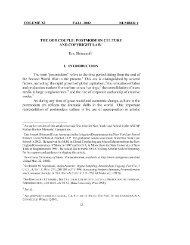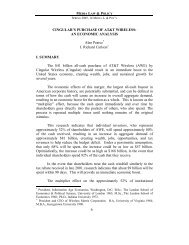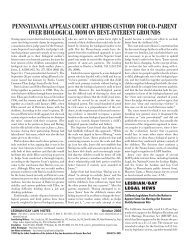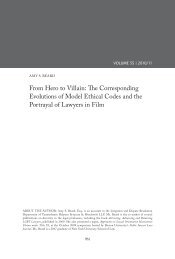The New Age of Scarlet-Letter Punishment - New York Law School
The New Age of Scarlet-Letter Punishment - New York Law School
The New Age of Scarlet-Letter Punishment - New York Law School
Create successful ePaper yourself
Turn your PDF publications into a flip-book with our unique Google optimized e-Paper software.
Justice Action Center<br />
Student Capstone Journal<br />
Project No. 07/08-01<br />
<strong>The</strong> <strong>New</strong> <strong>Age</strong> <strong>of</strong><br />
<strong>Scarlet</strong>-<strong>Letter</strong> <strong>Punishment</strong><br />
Sabrina Antebi<br />
<strong>New</strong> <strong>York</strong> <strong>Law</strong> <strong>School</strong><br />
Class <strong>of</strong> 2008<br />
This paper can be downloaded without charge from:<br />
www.nyls.edu/capstones<br />
Copyright 2008 by Author<br />
THIS PROJECT IS FOR INFORMATIONAL PURPOSES ONLY AND IS NOT A<br />
SUBSTITUTE FOR LEGAL ADVICE. BECAUSE THE LAW CHANGES QUICKLY, WE<br />
CANNOT GUARANTEE THAT THE INFORMATION PROVIDED IN THIS PROJECT<br />
WILL ALWAYS BE UP-TO-DATE OR CORRECT. IF YOU HAVE A LEGAL PROBLEM,<br />
WE URGE YOU TO CONTACT AN ATTORNEY.
Sabrina Antebi 1<br />
JAC Capstone<br />
<strong>The</strong> <strong>New</strong> <strong>Age</strong> <strong>of</strong> <strong>Scarlet</strong>-<strong>Letter</strong> <strong>Punishment</strong><br />
“<strong>The</strong>re can be no outrage, methinks, against our common nature, —whatever be the<br />
delinquencies <strong>of</strong> the individual— no outrage more flagrant than to forbid the culprit to hide his<br />
face for shame; as it was the essence <strong>of</strong> this punishment to do.”<br />
What is <strong>Scarlet</strong>-<strong>Letter</strong> <strong>Punishment</strong>?<br />
– Nathaniel Hawthorne, <strong>The</strong> <strong>Scarlet</strong> <strong>Letter</strong><br />
Members <strong>of</strong> society expect punishment to protect them from harm and to express moral<br />
disapprobation. 1 <strong>The</strong> most well-known and <strong>of</strong>ten used methods <strong>of</strong> punishment include<br />
imprisonment, fines, probation and community service. Different forms <strong>of</strong> punishment are<br />
beginning to emerge that challenge conventional notions <strong>of</strong> what punishment is all about. 2<br />
In recent years, scarlet-letter punishment has come back in vogue as an alternative to<br />
other popular sanctions. 3 <strong>The</strong>se penalties are designed to humiliate and degrade an <strong>of</strong>fender in<br />
public while inviting some element <strong>of</strong> public participation. 4 <strong>The</strong>se sentences reveal an <strong>of</strong>fender’s<br />
bad behavior to the public and force him or her to experience the uncomfortable exposure<br />
associated with the public announcement <strong>of</strong> his crime. 5 <strong>The</strong>y have reemerged primarily as a<br />
result <strong>of</strong> society’s skepticism that prison time, fines and parole do not effectively work to<br />
rehabilitate criminals. 6 <strong>The</strong>se penalties are typically reserved for sex and moral <strong>of</strong>fenses,<br />
1<br />
Dan M. Kahan, What’s Really Wrong with Shaming Sanctions, 84 TEX. L. REV. 2075, 2077<br />
(2006).<br />
2<br />
Stephen P. Garvey, Can Shaming <strong>Punishment</strong>s Educate?, 65 U. CHI. L. REV. 733, 733 (1998).<br />
3<br />
See, e.g., Aaron S. Book, Shame on You: An Analysis <strong>of</strong> Modern Shame <strong>Punishment</strong> as an<br />
Alternative to Incarceration, 40 WM. & MARY L. REV. 653, 660 (1999); James Q. Whitman,<br />
What is Wrong With Inflicting Shame Sanctions?, 107 YALE L.J. 1055, 1056 (1998).<br />
4<br />
Dan Markel, Wrong Turns on the Road to Alternative Sanctions: Reflections on the Future <strong>of</strong><br />
Shaming <strong>Punishment</strong>s and Restorative Justice, 1385 TEX. L. REV. 1385, 1389 (2007).<br />
5<br />
Jon A. Brilliant, <strong>The</strong> Modern Day <strong>Scarlet</strong> <strong>Letter</strong>: A Critical Analysis <strong>of</strong> Modern Probation<br />
Conditions, 1989 DUKE L.J. 1357, 1357 (1989).<br />
6<br />
See, e.g., Garvey, supra note 2, at 738.
Sabrina Antebi 2<br />
JAC Capstone<br />
commercial <strong>of</strong>fenses, and minor <strong>of</strong>fenses. 7 <strong>The</strong>y are usually imposed on first-time <strong>of</strong>fenders. 8<br />
<strong>The</strong>y are most likely handed down in state courts because state judges typically have broader<br />
discretion. 9<br />
Shaming penalties require an <strong>of</strong>fender to publicize his <strong>of</strong>fense to an audience that, under<br />
normal circumstances, would be unaware <strong>of</strong> it. 10 As a result <strong>of</strong> this publicity, the penalties cause<br />
the <strong>of</strong>fender to suffer an unpleasant, and likely painful, emotional experience. 11 To comprehend<br />
what constitutes scarlet-letter punishment, consider these recent examples <strong>of</strong> how judges across<br />
the county impose these types <strong>of</strong> penalties: a judge in Houston, Texas ordered that a warning<br />
sign be placed on the front door <strong>of</strong> a convicted child molester’s home. 12 <strong>The</strong> sign read, “No<br />
children under the age <strong>of</strong> 18 allowed on these premises by court order.” 13 <strong>The</strong> same judge<br />
required a witness who committed perjury to wear a sign in front <strong>of</strong> the courthouse that read, “I<br />
lied in court. Tell the truth or walk with me.” 14 Another judge in Houston ordered a man who<br />
pleaded guilty to domestic violence to stand on the steps <strong>of</strong> City Hall, face lunchtime workers,<br />
reporters and battered women’s advocates, and apologize for hitting his wife. 15 Authorities in<br />
Canton, Ohio and Miami, Florida place the names, addresses and ages <strong>of</strong> convicted prostitution<br />
7 Id. at 743.<br />
8 Id.<br />
9 Haya El Nasser, Paying for Crime With Shame, USA TODAY, June 25, 1996, at A1.<br />
10<br />
Id.<br />
11<br />
Id.<br />
12<br />
Ted Poe, Public Humiliation is Effective Deterrent, DALLAS MORNING NEWS, Apr. 11, 1997,<br />
at 31A.<br />
13<br />
Id.<br />
14<br />
Nicole Koch, Houston Judge Teaches “Humiliation in Sentencing,” WICHITA EAGLE, May 22,<br />
1997, at 17A.<br />
15 Paul Sperry, Throwing the Book – and Bible – at Texas’ Criminals, INVESTOR’S BUSINESS<br />
DAILY, Dec. 3, 1996, at A1.
Sabrina Antebi 3<br />
JAC Capstone<br />
solicitors on a cable television channel. 16 A state agency in Georgia posts on the internet the<br />
names and photos <strong>of</strong> parents who are delinquent with child support payments. 17 Judges in Texas<br />
have ordered shoplifters to parade in front <strong>of</strong> the stores they robbed, carrying posters admitting<br />
their guilt. 18 A Florida judge sentenced a mother who bought drugs in front <strong>of</strong> her children to<br />
take a newspaper ad telling the community what she had done. 19 <strong>The</strong>se are just some <strong>of</strong> the<br />
examples <strong>of</strong> the newly aggressive approaches by judges to send a message to <strong>of</strong>fenders, would-<br />
be <strong>of</strong>fenders, and the public.<br />
Shaming punishments are not only inflicted upon individuals. Every state has enacted<br />
some form <strong>of</strong> sex <strong>of</strong>fender registration legislation. 20 Registration requires that convicted sexual<br />
<strong>of</strong>fenders provide local authorities with information regarding their whereabouts and prior<br />
criminal history. 21 <strong>The</strong>se “Megan’s <strong>Law</strong>s” have been enacted at the state and federal level,<br />
which require released sex <strong>of</strong>fenders to register their home addresses with the states. Many states<br />
publicize this information on websites and through other means.<br />
How did the Concept <strong>of</strong> Shaming <strong>Punishment</strong>s Begin?<br />
During the 17 th and 18 th centuries, the most popular methods <strong>of</strong> punishment involved<br />
shaming penalties. 22 At that time, effective deterrence rested upon the shoulders <strong>of</strong> public<br />
humiliation. Public shaming constituted the most severe punishment and tended to cause more<br />
16<br />
Scott E. Sanders, Note, <strong>Scarlet</strong> <strong>Letter</strong>s, Bilboes and Cable TV: Are Shame <strong>Punishment</strong>s Cruel<br />
and Outdated or Are <strong>The</strong>y a Viable Option for American Jurisprudence?, 37 WASHBURN L.J.<br />
359, 370-71 (1998); NBC Nightly <strong>New</strong>s (broadcast Aug. 25, 1994).<br />
17<br />
Sanders, supra note 11, at 370.<br />
18<br />
See, e.g., id. at 367.<br />
19<br />
Fort Pierce Judge Tries Humiliating Defendants, FLORIDA TODAY, Dec. 6, 1996, at 5B.<br />
20<br />
Elizabeth Kelley Ciezniak, Note, <strong>The</strong>re Goes the Neighborhood: Notifying the Public When a<br />
Convicted Child Molester is Released Into the Community, 28 IND. L. REV. 715, 717 (1995).<br />
21<br />
See, e.g., People v. Ross, 646 N.Y.S.2d 249, 250 (1996); Sanders, supra note 17, at 372.<br />
22<br />
See, e.g., Brilliant, supra note 5, at 1362.
Sabrina Antebi 4<br />
JAC Capstone<br />
pain than physical beatings. 23 Shame punishments led to shunning by the community. 24 As a<br />
result, the threat <strong>of</strong> shame alone deterred crime and controlled deviant behavior. 25<br />
Shaming sanctions were successful because <strong>of</strong> the small size <strong>of</strong> American communities<br />
and intimate social structure in which members depended upon each other. 26 Most community<br />
members were life-long and the towns were essentially self-contained. 27 Shame punishment was<br />
based on one’s essential attachment to society. 28 In fact, at these times, the community was<br />
synonymous with life itself. 29<br />
As society developed, a more humanitarian approach to punishment evolved. By the 19 th<br />
century, shaming sanctions had become “worse than useless.” 30 One such explanation lay in the<br />
metamorphosis <strong>of</strong> American communities from small, intimate and tight-knit to urban, sprawling<br />
and anonymous. 31 As a result, the relationships amongst community members began to<br />
transform into more impersonal interactions. 32<br />
Another possible explanation is the changes in the composition and size <strong>of</strong> the<br />
population. 33 <strong>The</strong> 19 th century saw unprecedented population growth, new mobility and<br />
23<br />
Sanders, supra note 16, at 363.<br />
24<br />
Id. at 361.<br />
25<br />
Id.<br />
26<br />
Book, supra note 3, at 658.<br />
27<br />
ADAM JAY HIRSCH, THE RISE OF THE PENITENTIARY: PRISONS AND PUNISHMENT IN EARLY<br />
AMERICA 5 (Yale Univ. Press 1992); Barbara Clare Morton, Bringing Skeletons Out <strong>of</strong> the Closet<br />
and Into the Light- “<strong>Scarlet</strong> <strong>Letter</strong>” Sentencing Can Meet the Goals <strong>of</strong> Probation in Modern<br />
America Because it Deprives Offenders <strong>of</strong> Privacy, 35 SUFFOLK U.L. REV. 97, 103 (2001).<br />
28<br />
See, e.g., Book, supra note 3, at 658.<br />
29<br />
HARRY ELMER BARNES, THE STORY OF PUNISHMENT: A RECORD OF MAN’S INHUMANITY TO<br />
MAN 45, (Patterson Smith Publishing Corp. 1972).<br />
30<br />
HIRSCH, supra note 27, at 39; Sanders, supra note 16, at 365.<br />
31<br />
Sanders, supra note 16, at 365.<br />
32<br />
Id.<br />
33<br />
Matthew W. Meskell, <strong>The</strong> History <strong>of</strong> Prisons in the United States from 1777 to 1877, 51 STAN.<br />
L. REV. 839, 842 (1999).
Sabrina Antebi 5<br />
JAC Capstone<br />
diversification. 34 Citizens became more mobile and began migrating to large cities defined by<br />
autonomy and individuality. 35 <strong>The</strong> breakdown in the sense <strong>of</strong> community weakened the<br />
sensation <strong>of</strong> suffering that had accompanied public spectacles <strong>of</strong> shaming. 36<br />
<strong>The</strong> prison system was born as a result <strong>of</strong> increasing crime rates and the failure <strong>of</strong><br />
traditional punishments. 37 By the 1850’s, confinement had emerged as the new form <strong>of</strong><br />
punishment and social control <strong>of</strong> criminal behavior. 38<br />
Why Use Shame?<br />
<strong>The</strong> return to shaming penalties is to some extent a nostalgic longing for an era when a<br />
community and its principles were so uniform that people could police themselves. 39 <strong>The</strong><br />
primary reason for imposing these sanctions is economic. In 2006, there were approximately<br />
2.26 million people in state and federal prisons. 40 Prisons are costly and overused. 41 Today, the<br />
costs <strong>of</strong> imprisonment consume large shares <strong>of</strong> state budgets. 42<br />
Another reason used by supporters <strong>of</strong> these punishments is that imprisonment is<br />
sometimes too harsh <strong>of</strong> a punishment, and the other major alternative, probation, is too lenient. 43<br />
Judges tend not to use fines and community service all that much because they are “expressively<br />
34 HIRSCH, supra note 27, at 35; Meskell, supra note 33, at 842.<br />
35 Book, supra note 3, at 660.<br />
36 Deni Smith Garcia, Three Worlds Collide: A Novel Approach to the <strong>Law</strong>, Literature, and<br />
Psychology <strong>of</strong> Shame, 6 TEX. WESLEYAN L. REV. 105, 113 (1999).<br />
37 HIRSCH, supra note 27, at 39.<br />
38 Sanders, supra note 16, at 366.<br />
39 Jan H<strong>of</strong>fman, Crime and <strong>Punishment</strong>: Shame Gains Popularity, N.Y. TIMES, January 16,<br />
1997, at A1.<br />
40 U.S. Department <strong>of</strong> Justice, Bureau <strong>of</strong> Justice Statistics,<br />
http://www.ojp.usdoj.gov/bjs/prisons.htm (last visited April 21, 2008).<br />
41 Garvey, supra note 2, at 738.<br />
42 See id.<br />
43 Id. at 744.
Sabrina Antebi 6<br />
JAC Capstone<br />
inadequate.” 44 Fines can be thought <strong>of</strong> as ambiguous punishment because they make it look like<br />
<strong>of</strong>fenders can buy their way out <strong>of</strong> harsher punishment. 45 Community service receives criticism<br />
as punishment because it is supposed to be something civic-minded people do that wins them<br />
public praise and esteem. 46<br />
Shaming penalties, according to their supporters, express moral condemnation <strong>of</strong> the<br />
<strong>of</strong>fensive conduct far better than the alternatives. Proponents <strong>of</strong> scarlet-letter penalties argue that<br />
they effectively succeed in the main goals <strong>of</strong> punishment-namely, deterrence and rehabilitation.<br />
What is the Relationship Between Shaming and Deterrence?<br />
Supporters argue that shaming can deter future wrongdoing in three ways. First, these<br />
tactics impose some limitation on the <strong>of</strong>fender’s freedom, for example, by making the <strong>of</strong>fender<br />
wear a sign. 47 Second, they produce an unpleasant emotional experience, which potential<br />
<strong>of</strong>fenders will want to avoid and actual <strong>of</strong>fenders will want to avoid repeating. 48 Third, the<br />
<strong>of</strong>fender may suffer adverse consequences from members <strong>of</strong> the community, who may gossip<br />
about him or refuse to engage in social intercourse with him. 49<br />
In my opinion, these arguments are too speculative and problematic. Even though the<br />
criminals may have their freedom restricted, it will be in such a nominal way that it is unlikely to<br />
make a big impact. And this restriction is nothing when compared with the restrictions imposed<br />
on criminals who are sentenced to imprisonment, and who will be fully deprived <strong>of</strong> their liberty.<br />
Furthermore, it is unclear to what degree these <strong>of</strong>fenders may suffer unpleasant emotions. Each<br />
44<br />
Dan M. Kahan, What Do Alternative Sanctions Mean?, 63 U. CHI. L. REV. 591, 622 (1996).<br />
45<br />
Id. at 622-24.<br />
46<br />
Id. at 627-29.<br />
47<br />
Garvey, supra note 2, at 751.<br />
48<br />
Id.<br />
49<br />
Id. at 751-52.
Sabrina Antebi 7<br />
JAC Capstone<br />
person will react differently, which will largely depend on his community, his status and his past<br />
experiences. <strong>The</strong>se effects need to be measured individually and in this context, it is virtually<br />
impossible.<br />
While I do agree that <strong>of</strong>fenders may suffer adverse consequences from the community, I<br />
also find that not everyone cares about being “accepted.” A community may be so atomized that<br />
no one cares about what other people think about anyone else. 50 This is very plausible in today’s<br />
world, where technology and traveling abilities help fragment communities and allow individuals<br />
to remain more independent and anonymous. Additionally, when shame does work, it may push<br />
an <strong>of</strong>fender further into criminality. 51 <strong>The</strong> penalties may stigmatize or label him as a criminal,<br />
which can cause him to think he needs to behave like criminal. 52<br />
What is the Relationship Between Shaming and Rehabilitation?<br />
Another purpose <strong>of</strong> punishment is rehabilitation. 53 Rehabilitation is meant to forestall<br />
future <strong>of</strong>fenses by changing the defendant’s preferences. 54 <strong>The</strong> rehabilitated <strong>of</strong>fender accepts<br />
that what he did was wrong and, out <strong>of</strong> respect for the law and the rights <strong>of</strong> others, no longer<br />
thinks it is morally acceptable to violate either <strong>of</strong> them. 55 Thus far, the power <strong>of</strong> shaming<br />
sanctions to rehabilitate has been questionable. Courts have increasingly struck down these types<br />
<strong>of</strong> penalties after finding that they are punitive, and not rehabilitative. 56<br />
50 Id. at 753; Sanders, supra note 16, at 360.<br />
51 Garvey, supra note 2, at 752.<br />
52 Id.<br />
53 See, e.g., Book, supra note 3, at 656, 678; Sanders, supra note 16, at 359.<br />
54 See, Garvey, supra note 2, at 757.<br />
55 Id.<br />
56 Book, supra note 3, at 656; Garvey, supra note 2, at 757.
Sabrina Antebi 8<br />
JAC Capstone<br />
Furthermore, the punitive effects <strong>of</strong> requiring the <strong>of</strong>fender to publicize his conviction in<br />
nearly every aspect <strong>of</strong> his life clearly outweigh the rehabilitative effects. <strong>The</strong>se punishments will<br />
humiliate the defendants and cause the public to disassociate themselves from them. It is<br />
important to remember that the primary purpose <strong>of</strong> probation is to reintegrate the defendant into<br />
society. <strong>The</strong> humiliation punishments will frustrate this goal.<br />
Should Preferences Matter?<br />
Proponents <strong>of</strong> shaming argue that these sanctions should be upheld because they are <strong>of</strong>ten<br />
the mode <strong>of</strong> punishment chosen by <strong>of</strong>fenders. 57 This argument must be looked at in context.<br />
Society should not rely on the preference <strong>of</strong> <strong>of</strong>fenders as a measure <strong>of</strong> the relative cruelty<br />
between incarceration and shaming. 58 It is no surprise that criminal <strong>of</strong>fenders are willing to<br />
choose shaming over the other viable option <strong>of</strong> prison. Such choice is likely based on the<br />
duration <strong>of</strong> the punishment rather than its intensity or intrinsic cruelty. 59 Typical shaming<br />
punishments have thus far been relatively brief when juxtaposed against the duration <strong>of</strong><br />
incarceration sentences. 60 If prisons were the benchmarks for alternative sanctions, then virtually<br />
anything would be an improvement and worth trying. 61 People would perhaps be more willing to<br />
have two pinkies cut <strong>of</strong>f to avoid having to spend a year in prison away from their family, but<br />
that does not necessarily mean the state should be in the business <strong>of</strong> punishing people by cutting<br />
<strong>of</strong>f fingers or that such punishments are less cruel. 62 Thus, shaming penalties seem far more<br />
57<br />
Kahan, supra note 1, at 2080.<br />
58<br />
Markel, supra note 4, at 1401.<br />
59<br />
Id.<br />
60<br />
See, e.g., Book, supra note 3, at 653-54.<br />
61<br />
Toni M. Massaro, <strong>The</strong> Meaning <strong>of</strong> Shame, 3 PSYCHOL. PUB. POL’Y & L. 645, 696-97 (1997).<br />
62 Id.
Sabrina Antebi 9<br />
JAC Capstone<br />
attractive to potential prison inmates. Furthermore, since shaming sanctions are relatively new<br />
and rare, <strong>of</strong>fenders who have never been publicly shamed may discount the cruelty. 63<br />
Why is Shaming Bad?<br />
Despite the disagreements over the real purposes and effects <strong>of</strong> retributive punishment,<br />
there is consensus over one thing: punishment should be proportionate to the <strong>of</strong>fense. 64 One <strong>of</strong><br />
the problems with shaming sanctions is that they are difficult to balance. It is difficult to<br />
disseminate information regarding the illegal activity in a way that is proportional to the severity<br />
<strong>of</strong> the <strong>of</strong>fense. 65 On one hand, these punishments can be disproportionately too weak on those<br />
<strong>of</strong>fenders who are socially alienated. 66 In order for these penalties to work, a person has to care<br />
about what others think about him or her. Additionally, there are criminal sub-cultures in which<br />
shaming may become a source <strong>of</strong> pride. 67 This cannot be said <strong>of</strong> the other types <strong>of</strong> punishment.<br />
On the other hand, these types <strong>of</strong> penalties may be too strong. 68 Since these punishments<br />
invoke a person’s emotions, they can have dire consequences. <strong>The</strong>y can cause the <strong>of</strong>fenders to<br />
avoid the community and alienate themselves from others. 69 At the extreme, shame can result in<br />
self-destruction, and the person may attempt to rid those emotions through suicide. 70 Such case<br />
may seem inconceivable, but consider the following news story: In Georgia, a man was<br />
63 Markel, supra note 4, at 1402.<br />
64 Garvey, supra note 2, at 747.<br />
65 Alon Harel & Alon Klement, <strong>The</strong> Economics <strong>of</strong> Shame: Why More Shaming May Deter Less,<br />
15-16 (August 24, 2005) (unpublished manuscript, available at http://ssrn.com/abstract=789244).<br />
66 Garvey, supra note 2, at 749.<br />
67<br />
Id.; El Nasser, supra note 9.<br />
68<br />
Garvey, supra note 2, at 749.<br />
69<br />
Id. at 752.<br />
70<br />
Book, supra note 3, at 684.
Sabrina Antebi 10<br />
JAC Capstone<br />
convicted <strong>of</strong> drunk driving. 71 As a condition <strong>of</strong> his sentence, the judge required that a photograph<br />
<strong>of</strong> the man appear in the local newspaper. 72 <strong>The</strong> man had not told his mother <strong>of</strong> his conviction. 73<br />
She saw his picture in the newspaper and left him a note that described the horrid shame she was<br />
experiencing. 74 Distraught and embarrassed after reading the note, the man committed suicide. 75<br />
Proponents <strong>of</strong> shaming sanctions argue that imprisonment is cruel, degrading and more<br />
likely to “vitiate the reputational stake a person has in resuming a law-abiding life that shaming<br />
is.” 76 <strong>The</strong>se claims warrant scrutiny. <strong>The</strong>re are minimum-security prison facilities available for<br />
the types <strong>of</strong> <strong>of</strong>fenders for whom shaming punishments are not an option. 77 <strong>The</strong>se facilities do not<br />
even endeavor to destroy an <strong>of</strong>fender’s basic human dignity. 78 In fact, a substantial part <strong>of</strong> the<br />
prison population is housed in these types <strong>of</strong> facilities. 79<br />
What are Some Problems with Shaming as Applied in Today’s World?<br />
From its history, it appears that scarlet letter sanctioning can successfully control and<br />
deter criminal conduct only under very limited societal conditions, which are virtually non-<br />
existent today. 80 <strong>The</strong> rise <strong>of</strong> the penitentiary and continual use <strong>of</strong> that institution attests to the<br />
failure <strong>of</strong> shaming sanctions under modern conditions. 81<br />
71 Id.<br />
72 Id.<br />
73 Id. at 685.<br />
74 Id.<br />
75 Id.<br />
76 Kahan, supra note 1, at 2080.<br />
77 Markel, supra note 4, at 1399.<br />
78 Id.<br />
79 Id. at 1399-1400.<br />
80 Toni M. Massaro, Shame, Culture and American Criminal <strong>Law</strong>, 89 MICH. L. REV. 1880, 1922<br />
(1991).<br />
81 Morton, supra note 27, at 109.
Sabrina Antebi 11<br />
JAC Capstone<br />
In the shaming context today there are problems with the public bearing witness to such<br />
spectacles. <strong>The</strong> anonymous, diverse, impersonal texture <strong>of</strong> today’s society is not conducive to<br />
eliciting feelings <strong>of</strong> shame. 82 <strong>The</strong> American way <strong>of</strong> encouraging independence and individuality<br />
necessarily reduces the effectiveness <strong>of</strong> shaming. 83 People are wrapped up in their own worlds<br />
and are concerned with their own lives, so it is quite unlikely that they would respond<br />
apathetically to such a public spectacle <strong>of</strong> shaming. 84 As one commentator noted about today’s<br />
society: “It is doubtful that in today’s hectic, commuter-world people would congregate to<br />
witness someone’s public shaming…Even a bumper sticker posted on an <strong>of</strong>fender’s car would<br />
probably get a mere glance at best.” 85 <strong>The</strong> community is unlikely to react to the public spectacle<br />
in a way that will lead to the emotions and guilt needed for the <strong>of</strong>fenders’ deterrence and<br />
rehabilitation.<br />
Is Shaming Undignified?<br />
Shaming penalties are cruel, degrading and inhumane. 86 <strong>The</strong>y violate an <strong>of</strong>fender’s<br />
dignity, which no morally decent state should do. 87 State enforced shaming authorizes public<br />
<strong>of</strong>ficials to search for and damage an <strong>of</strong>fender’s dignity. 88 Mark Kappelh<strong>of</strong>f, <strong>of</strong> the American<br />
Civil Liberties Union, sums up shame punishment by referring to it as “gratuitous humiliation <strong>of</strong><br />
the individual that serves no societal purpose at all”. 89<br />
82 Garcia, supra note 36, at 116.<br />
83 Massaro, supra note 80, at 1924.<br />
84 Garcia, supra note 36, at 126.<br />
85 Id.<br />
86 Garvey, supra note 2, at 757.<br />
87 Id.<br />
88 Massaro, supra note 80, at 1943.<br />
89 Tony Allen-Mills, American Criminals Sentenced to Shame, TIMES (London), Apr. 20, 1997,<br />
at 23.
Sabrina Antebi 12<br />
JAC Capstone<br />
<strong>The</strong> supporters <strong>of</strong> shaming penalties argue that since the alternative to shame is<br />
imprisonment, then shame simply substitutes one set <strong>of</strong> indignities for another. 90 What’s missing<br />
from this argument is the fact that shaming encourages others to bear witness to the <strong>of</strong>fender’s<br />
indignities. 91 Individuals who are imprisoned for a certain period <strong>of</strong> time are able to remain<br />
relatively anonymous since they do not walk around announcing their convictions to society. 92<br />
On the other hand, those individuals who are subjected to shaming sanctions carry with them a<br />
public stigma that is not easily forgotten or ignored.<br />
Should <strong>Punishment</strong> Focus on Shame or Guilt?<br />
Shaming differs from other methods <strong>of</strong> punishment in that its effectiveness depends on<br />
the reaction <strong>of</strong> members <strong>of</strong> society or in the market to the public information concerning the<br />
<strong>of</strong>fender’s behavior. 93 <strong>Punishment</strong>, no matter what form, should be premised on guilt and not on<br />
shame. Shame involves the idea <strong>of</strong> an audience, whereas guilt involves no such connection. 94<br />
Guilt focuses on the individual’s particular act <strong>of</strong> wrongdoing, whereas shame focuses on the<br />
person as a whole. 95 <strong>The</strong>se emotions also differ in their elicited responses. 96 Shame prompts one<br />
to hide or to strike back at the source <strong>of</strong> shame. 97 On the other hand, guilt prompts the person to<br />
90<br />
Garvey, supra note 2, at 760.<br />
91<br />
Id.<br />
92<br />
Id.<br />
93<br />
Harel & Klement, supra note 65, at 1.<br />
94<br />
GABRIELE TAYLOR, PRIDE, SHAME AND GUILT: EMOTIONS OF SELF-ASSESSMENT 53,<br />
(Clarendon Press, 1985); Garvey, supra note 2, at 766-67.<br />
95<br />
Garvey, supra note 2, at 766.<br />
96<br />
Id.<br />
97<br />
Garvey, supra note 2, at 766; June Price Tangney, et al., Shamed into Anger? <strong>The</strong> Relation <strong>of</strong><br />
Shame and Guilt to Anger and Self-Reported Aggression, 62 J. PERSONALITY & SOC. PSYCHOL.<br />
669, 669 (1992).
Sabrina Antebi 13<br />
JAC Capstone<br />
try to make amends for the wrongdoing. 98 Rehabilitation should not depend on the response <strong>of</strong><br />
other people; it should be an intrinsic process that an individual experiences from his own<br />
emotions. Of course, eliciting a particular emotional response from a person is not an exact<br />
science. 99 However, if the state is going to aim at any such response, then it should be guilt. 100<br />
Is This the Beginning <strong>of</strong> Shifting Trends?<br />
Dan Kahan, a national expert on shame penalties, and a well-known proponent <strong>of</strong> them,<br />
recently recanted his position. 101 He admits that there is no statistical evidence showing that<br />
shaming works to rehabilitate or deter. 102 Kahan argues that the problem with shaming penalties<br />
is that they are deeply partisan. 103 When shaming penalties are deployed, they signal that society<br />
has chosen sides with those who elevate community values over individuality and equality. 104 He<br />
argues that imprisonment is pluralistic, which is why it works so well as a punishment. 105<br />
Persons <strong>of</strong> all cultures and worldviews can understand it and can appreciate it as a means <strong>of</strong><br />
punishment. 106 Since one <strong>of</strong> the most well known advocates for shame punishments just<br />
renounced his position, it will only be a matter <strong>of</strong> time before others will follow his lead.<br />
98<br />
Garvey, supra note 2, at 766.<br />
99<br />
Id. at 767.<br />
100<br />
Id. at 767; June Price Tangney, Recent Advances in the Empirical Study <strong>of</strong> Shame and Guilt,<br />
28 AM. BEHAV. SCI. 1132, 1142 (1995).<br />
101<br />
Kahan, supra note 1.<br />
102<br />
El Nasser, supra note 9.<br />
103<br />
Kahan, supra note 1, at 2076.<br />
104<br />
Id.<br />
105<br />
Id.<br />
106<br />
Id.
Sabrina Antebi 14<br />
JAC Capstone<br />
What are Viable Alternatives?<br />
To fashion an acceptable alternative to imprisonment, it is necessary to identify a form <strong>of</strong><br />
punishment that not only condemns as forcefully as imprisonment, but that also condemns as<br />
ambiguously as imprisonment. 107 Kahan, and Stephen Garvey, an opponent <strong>of</strong> these penalties,<br />
introduced two such models. A third alternative, therapeutic jurisprudence, is a preventive law<br />
model.<br />
Kahan introduced a model <strong>of</strong> restorative justice. Restorative justice is the term given to a<br />
variety <strong>of</strong> different practices, including apologies, restitution, and acknowledgments <strong>of</strong> harm and<br />
injury, as well as to other efforts to provide healing and reintegration <strong>of</strong> <strong>of</strong>fenders into their<br />
communities. 108 Under this model, the <strong>of</strong>fender, victim and representatives <strong>of</strong> the community<br />
participate in an informal mediation process. 109 <strong>The</strong> participants would negotiate an appropriate<br />
course <strong>of</strong> action, which would typically include some type <strong>of</strong> apology by the <strong>of</strong>fender and an<br />
agreement to furnish monetary or other types <strong>of</strong> reparation to the victim. 110 Proponents suggest<br />
that by providing structured environments in which <strong>of</strong>fenders and victims meet and explain their<br />
injuries and hurts to each other, <strong>of</strong>fenders could acknowledge and explain their bad acts,<br />
apologize and make restitution to victims who could forgive and feel safe again. 111 Restorative<br />
justice programs promote a healing response by creating an atmosphere <strong>of</strong> rapprochement and<br />
then by initiating a process by which the <strong>of</strong>fender can help make the victim whole. 112 <strong>The</strong>se<br />
programs emphasize the need to treat <strong>of</strong>fenders with respect and to reintegrate them into the<br />
107<br />
Id.<br />
108<br />
Carrie Menkel-Meadow, Restorative Justice: What is it and Does it Work?, 115 ANN. REV. L.<br />
OF SOC. SCI. 161,162 (2007).<br />
109<br />
Kahan, supra note 1, at 2090-91.<br />
110<br />
Id. at 2091.<br />
111<br />
Menkel-Meadow, supra note 108, at 163.<br />
112<br />
Kahan, supra note 1, at 2092.
Sabrina Antebi 15<br />
JAC Capstone<br />
community. 113 Additionally, this type <strong>of</strong> program could be beneficial to victims, who would no<br />
longer be frightened or traumatized by what happened to them. 114 For these reasons, most people<br />
approve <strong>of</strong> restorative justice because they see it as “as accentuating, not muting denunciation <strong>of</strong><br />
<strong>of</strong>fenders.” 115<br />
Garvey concedes that shaming punishments may successfully condemn and may even be<br />
effective deterrents, but they do little to educate. 116 Thus, he introduces a theory <strong>of</strong> moral reform,<br />
which in essence is an educating model. 117 <strong>The</strong> idea behind this theory is that punishments<br />
should aim to reflect back on the <strong>of</strong>fender what he has done to his victim. 118 Under this model,<br />
punishment is seen as a mode <strong>of</strong> bilateral communication. 119 <strong>The</strong> goal <strong>of</strong> punishment is the<br />
<strong>of</strong>fender’s moral education or reform. 120 This model requires the <strong>of</strong>fender to be treated as a<br />
responsible, autonomous agent and not merely as an object to be manipulated through coercion<br />
and fear. 121 It seeks education, not indoctrination. 122 It prides itself on treating the <strong>of</strong>fender as a<br />
responsible moral agent. 123<br />
This theory forces the <strong>of</strong>fender to repair the particular harm he caused, and not to simply<br />
provide some general service to the community. 124 It urges that sanctions be designed in a way<br />
113<br />
Id.; Menkel-Meadow, supra note 108, at 163.<br />
114<br />
Menkel-Meadow, supra note 108, at 163.<br />
115<br />
Kahan, supra note 1, at 2092.<br />
116<br />
Garvey, supra note 2, at 784.<br />
117<br />
Id. at 738.<br />
118<br />
Id. at 739.<br />
119<br />
Id. at 763; R.A. Duff, Penal Communications: Recent Work in the Philosophy <strong>of</strong> <strong>Punishment</strong>,<br />
in 20 CRIME AND JUSTICE: A REVIEW OF RESEARCH 1, 33 (Michel Tonry ed., 1996).<br />
120<br />
Garvey, supra note 2, at 764; ROBERT NOZICK, PHILOSOPHICAL EXPLANATIONS, 371 (Harvard<br />
Univ. Press, 1981).<br />
121 Garvey, supra note 2, at 764.<br />
122 Id. at 765.<br />
123 Id.<br />
124 Id. at 791; Randy Barnett, Restitution: A <strong>New</strong> Paradigm <strong>of</strong> Criminal Justice, 87 ETHICS 279,<br />
288-91 (1977).
Sabrina Antebi 16<br />
JAC Capstone<br />
that makes an <strong>of</strong>fender experience the harm he has caused, either directly or vicariously. 125 <strong>The</strong><br />
aim is to get the <strong>of</strong>fender to reform himself. 126 Rather than simply “yelling” at the <strong>of</strong>fender as in<br />
the shaming model, punishment in the educating model is intended to speak to the <strong>of</strong>fender so<br />
that he will learn from what is said. 127 <strong>The</strong> other modes <strong>of</strong> punishment fail to provide such<br />
education. 128 For example, probation may limit what an <strong>of</strong>fender can and cannot do, but it does<br />
not show him why his actions were wrong. 129 Likewise, community service may introduce the<br />
<strong>of</strong>fender to the virtue <strong>of</strong> helping others but, again, it does nothing to show the <strong>of</strong>fender why his<br />
actions were wrong. 130 Fines simply transfer wealth from the <strong>of</strong>fender to the state without any<br />
explanations <strong>of</strong> his actions. 131<br />
Apology plays a major role in the moral education theory. In this model, however, the<br />
emphasis is on the apology and not the shame that might accompany it when it is given in<br />
public. 132 Thus, the educating model would urge the <strong>of</strong>fender to make the apology in private. 133<br />
At the end <strong>of</strong> the process the <strong>of</strong>fender comes through punishment to understand the nature <strong>of</strong> his<br />
<strong>of</strong>fense, to experience guilt, and to repent his wrongdoing and seek to make amends. 134<br />
Part <strong>of</strong> the moral education theory is the idea <strong>of</strong> lex talionis, which requires that the<br />
punishment mirrors the harm caused. 135 However, Garvey emphasizes that the idea <strong>of</strong> “an eye<br />
125<br />
Garvey, supra note 2, at 780.<br />
126<br />
Id. at 763; NOZICK, supra note 120, at 371.<br />
127<br />
Garvey, supra note 2, at 763.<br />
128<br />
Id. at 771.<br />
129<br />
Id.<br />
130<br />
Id.<br />
131<br />
Id.<br />
132<br />
Id. at 792.<br />
133<br />
Id.<br />
134<br />
Id. at 765.<br />
135<br />
Id. at 776.
Sabrina Antebi 17<br />
JAC Capstone<br />
for an eye” should not be construed literally. 136 As an example, he demonstrates a possible<br />
punishment for those convicted <strong>of</strong> rape. <strong>The</strong> <strong>of</strong>fenders should experience the trauma vicariously,<br />
by being forced to listen to the words and accusations <strong>of</strong> rape victims, and by engaging in role-<br />
playing in which they assume the role <strong>of</strong> the women they raped. 137 Another example is to deny a<br />
convicted perjurer access to courts for a specified period <strong>of</strong> time, with the view that the <strong>of</strong>fender<br />
might learn the value <strong>of</strong> preserving the courts’ integrity. 138<br />
<strong>The</strong>rapeutic jurisprudence is a preventive law model that seeks to alleviate the need for<br />
shaming sanctions. It is an interdisciplinary approach to legal scholarship and law reform that<br />
sees law itself as a therapeutic agent. 139 It proposes that we be sensitive to the consequences <strong>of</strong><br />
governmental action and that we ask whether the law’s anti-therapeutic consequences can be<br />
reduced and its therapeutic consequences enhanced without subordinating due process and<br />
justice values. 140 This model contemplates lawyers practicing with an ethic <strong>of</strong> care and<br />
heightened interpersonal skills while seeking to prevent legal difficulties through sensitive<br />
counseling and advanced planning. 141 It necessitates increased psychological sensitivity in the<br />
attorney-client relationship, enhanced interpersonal skills, interviewing and counseling<br />
techniques, and approaches for dealing with the emotional issues that are likely to come up in the<br />
136<br />
Id. at 778.<br />
137<br />
Id. at 781.<br />
138<br />
Jeremy Waldron, Lex Talionis, 34 ARIZ. L. REV. 25, 44 (1992).<br />
139<br />
DAVID B. WEXLER AND BRUCE J. WINICK, ESSAYS IN THERAPEUTIC JURISPRUDENCE (Carolina<br />
Academic Press 1991).<br />
140<br />
David Wexler, <strong>New</strong> Directions in <strong>The</strong>rapeutic Jurisprudence: <strong>Law</strong> & Mental Health<br />
Scholarship Outside the Conventional Context <strong>of</strong> Mental Health <strong>Law</strong>, 10 N.Y.L. SCH. J. HUM.<br />
RTS. 759, 762 (1993).<br />
141<br />
Bruce J. Winick and David B. Wexler, <strong>The</strong> Use <strong>of</strong> <strong>The</strong>rapeutic Jurisprudence in <strong>Law</strong> <strong>School</strong><br />
Clinical Education: Transforming the Criminal <strong>Law</strong> Clinic, 13 CLINICAL LAW REVIEW 605, 606<br />
(2006).
Sabrina Antebi 18<br />
JAC Capstone<br />
legal encounter. 142 <strong>The</strong> criminal defense attorney informs the client <strong>of</strong> options and attempts to<br />
persuade the client to consider rehabilitative possibilities. 143 <strong>The</strong>rapeutic jurisprudence is<br />
committed to client-centered counseling. 144 <strong>The</strong> client’s direct involvement in creating a success<br />
plan can increase the likelihood that he will comply with it and benefit therefrom. 145 All <strong>of</strong> these<br />
models show that there are feasible alternatives to scarlet letter punishment.<br />
What are Some Proposed Solutions?<br />
<strong>The</strong> simplest solution is to do away with these shaming practices because they serve no<br />
societal purpose. In order to do this, studies need to be conducted to show that there is little, if<br />
any, correlation between shaming punishments and rehabilitation or deterrence. In 2005, Alon<br />
Harel and Alon Klement conducted one such study. 146 <strong>The</strong>ir research showed that there is an<br />
inverse relationship between the rate <strong>of</strong> shaming penalties and their deterrent effects. 147 <strong>The</strong>y<br />
found that wide-ranging use <strong>of</strong> shaming penalties is likely to erode their effectiveness and that<br />
their extensive use as a substitute for traditional sanctions may undermine their deterrent<br />
effects. 148 Legislatures and judges should be informed <strong>of</strong> this so that they can see for themselves<br />
that these punishments do not succeed at one <strong>of</strong> their primary purposes: deterrence.<br />
It needs to be shown that these types <strong>of</strong> sanctions violate the eighth amendment in that<br />
they are cruel and unusual punishments. In the case Trop v. Dulles, the court stated that the<br />
142 Id. at 609.<br />
143 Id. at 614.<br />
144 Bruce J. Winick, Redefining the Role <strong>of</strong> the Criminal Defense <strong>Law</strong>yer in Plea Bargaining and<br />
Sentencing: A <strong>The</strong>rapeutic Jurisprudence/Preventative <strong>Law</strong> Model, in PRACTICING THERAPEUTIC<br />
JURISPRUDENCE: LAW AS A HELPING PROFESSION, 245 (Dennis P. Stolle, David B. Wexler, &<br />
Bruce J. Winick, eds., 2000).<br />
145 Winick & Wexler, supra note 141, at 621.<br />
146 Harel & Klement, supra note 65.<br />
147 Id. at 1.<br />
148 Id. at 1-2.
Sabrina Antebi 19<br />
JAC Capstone<br />
meaning <strong>of</strong> the eighth amendment must be drawn from the “evolving standards <strong>of</strong> human<br />
decency that mark the progress <strong>of</strong> a maturing society.” <strong>Scarlet</strong>-letter sanctioning should be struck<br />
down under this standard. As society continues to evolve, so do its methods <strong>of</strong> punishment.<br />
Society should not sanction a condition that deprives a man <strong>of</strong> his dignity by holding him out for<br />
public ridicule in every aspect <strong>of</strong> his life.<br />
Another possible argument is that shaming sanctions infringe upon the defendants’ first<br />
amendment privacy rights. Thus far, this argument has proven to be ineffective. 149 Sentencing<br />
judges enjoy broad discretion authorized by statute when crafting probation sentences. 150 A<br />
reviewing court tends to invalidate probation sentences only if it finds the penalty to be<br />
unreasonable, unrelated to the goals <strong>of</strong> probation, or an abuse <strong>of</strong> discretion. 151 Additionally, the<br />
United States Supreme Court has recognized that probationers do not enjoy the same degree <strong>of</strong><br />
constitutional protections as do law-abiding citizens. 152 Although this argument has not yet been<br />
successful, it is important to continue raising it.<br />
<strong>The</strong> problem with these shaming tactics is best described by Erwin Chemerinsky, a<br />
prominent law pr<strong>of</strong>essor: “<strong>The</strong> real measure <strong>of</strong> how civilized we are is the way we choose to<br />
punish people. It is not civilized to tell somebody you’re going to sit in the stocks and we’re<br />
149 See, e.g., Goldschmitt v. State, 490 So. 2d 123, 125 (Fla. 1986) (holding that it was<br />
constitutional to order a convicted drunk driver to affix a bumper sticker to his car that read<br />
“Convicted D.U.I.-Restricted License” because the message was a form <strong>of</strong> penance and a<br />
warning to other potential wrongdoers); Ballenger v. State, 436 S.E.2d 793, 795 (Ga. 1993)<br />
(holding that it was not an infringement <strong>of</strong> convicted drunk driver’s constitutional rights to make<br />
him wear a fluorescent pink bracelet imprinted with the words “D.U.I Convict” because it had<br />
possible rehabilitative and deterrent effects and because the sentence can also help protect<br />
society).<br />
150 Morton, supra note 27, at 117.<br />
151 See, e.g., People v. Dominguez, 64 Cal. Rptr. 290, 293 (Cal. 1977); Rodriguez v. State, 378<br />
So. 2d 7, 9 (Fla. 1979); Morton, supra note 27, at 117.<br />
152 Griffin v. Wisconsin, 483 U.S. 868, 874 (1987); United States v. Consuelo-Gonzalez, 521<br />
F.2d 259, 265 (9 th Cir. 1975).
Sabrina Antebi 20<br />
JAC Capstone<br />
going to throw stones at you.” 153 Every country deals with criminals in its own way. We, as the<br />
American public, need to set examples and show that these <strong>of</strong>fenders deserve, and can benefit<br />
from, another chance. We cannot engage in these inhumane punishments, especially when there<br />
is a lack <strong>of</strong> evidence showing that are effective in deterrence or rehabilitation.<br />
153 El Nasser, supra note 9.


